Pestle and Swot Analysis of Business Environment
VerifiedAdded on 2020/10/05
|16
|4712
|214
AI Summary
The provided document is an analysis of the business environment using PESTLE (Political, Economic, Social, Technological, Legal, and Environmental) and SWOT (Strengths, Weaknesses, Opportunities, and Threats) methods. The document includes a list of references from various academic sources, such as journals, books, and online resources. It also mentions specific topics, including innovation clusters, public-private partnerships, and business process standardization. The purpose of the assignment is to understand how these factors influence business environments and entrepreneurship globally.
Contribute Materials
Your contribution can guide someone’s learning journey. Share your
documents today.
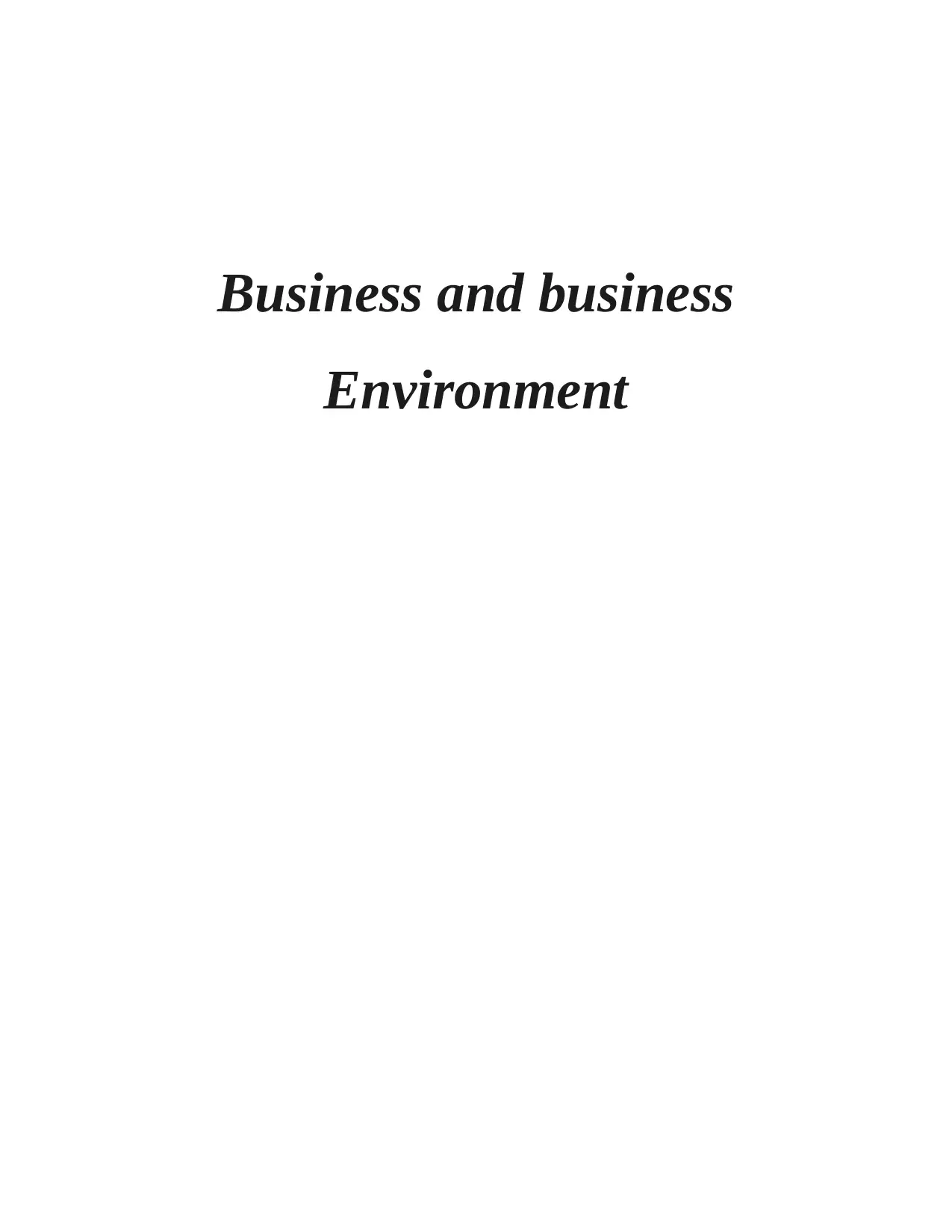
Business and business
Environment
Environment
Secure Best Marks with AI Grader
Need help grading? Try our AI Grader for instant feedback on your assignments.
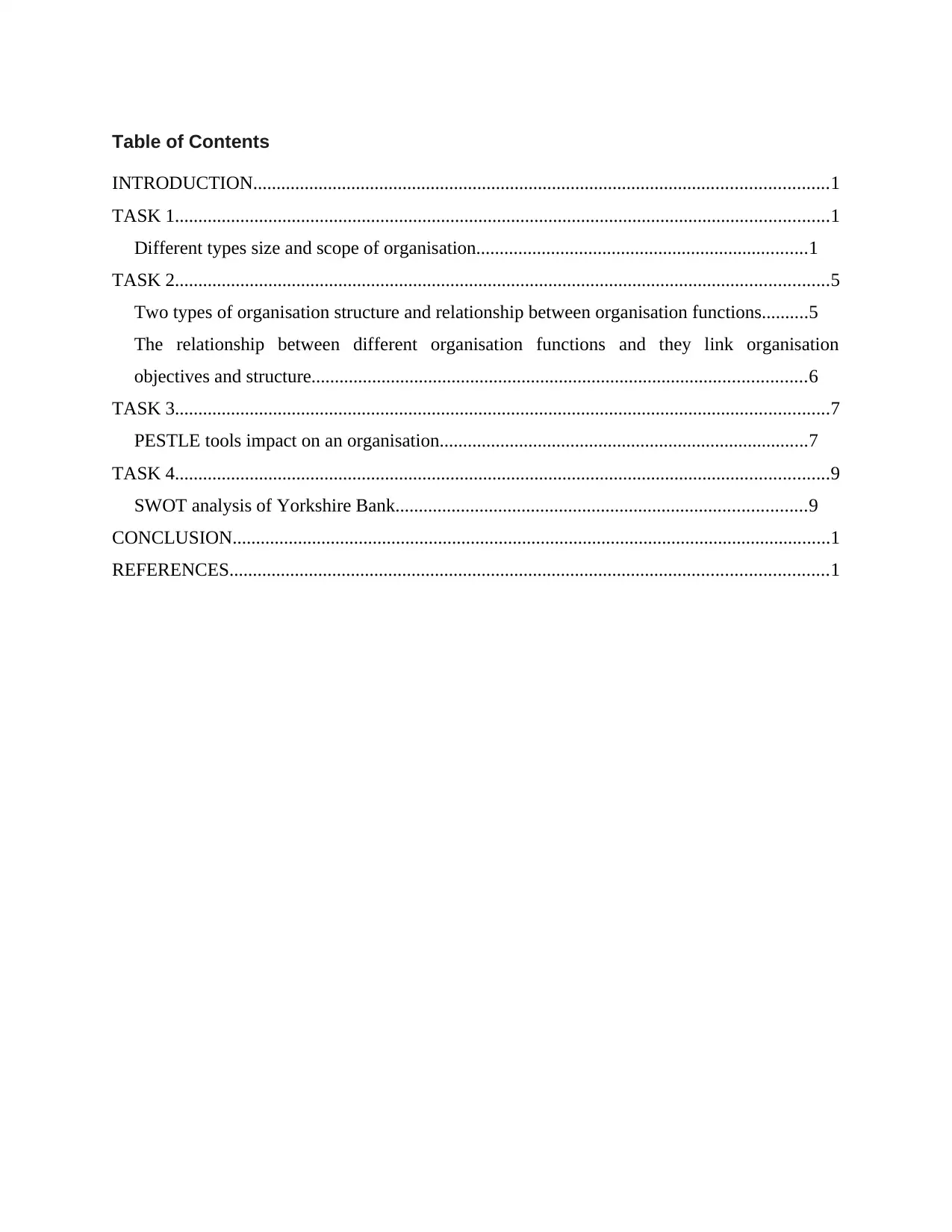
Table of Contents
INTRODUCTION...........................................................................................................................1
TASK 1............................................................................................................................................1
Different types size and scope of organisation.......................................................................1
TASK 2............................................................................................................................................5
Two types of organisation structure and relationship between organisation functions..........5
The relationship between different organisation functions and they link organisation
objectives and structure..........................................................................................................6
TASK 3............................................................................................................................................7
PESTLE tools impact on an organisation...............................................................................7
TASK 4............................................................................................................................................9
SWOT analysis of Yorkshire Bank........................................................................................9
CONCLUSION................................................................................................................................1
REFERENCES................................................................................................................................1
INTRODUCTION...........................................................................................................................1
TASK 1............................................................................................................................................1
Different types size and scope of organisation.......................................................................1
TASK 2............................................................................................................................................5
Two types of organisation structure and relationship between organisation functions..........5
The relationship between different organisation functions and they link organisation
objectives and structure..........................................................................................................6
TASK 3............................................................................................................................................7
PESTLE tools impact on an organisation...............................................................................7
TASK 4............................................................................................................................................9
SWOT analysis of Yorkshire Bank........................................................................................9
CONCLUSION................................................................................................................................1
REFERENCES................................................................................................................................1

INTRODUCTION
Business environment means that all external and internal factors which is impacted on
business supply, demand and regulation (Banica and Hagiu, 2015). Report will be based on
“YORKSHIRE BANK”. It was established on 1859. Its headquarter establish in Leeds, England
Report will cover different types, size, scope of public private and voluntary organisation
and advantages and disadvantages along with some differences. It discusses that organisation
operate in the primary, secondary sector. It will cover interrelationship of the various function
within an organisation and examples of positive and negative impact on the business operations.
It discuses about the SWOT analysis of Yorkshire bank and also evaluate the impact factors up
on business decision making.
TASK 1
Different types size and scope of organisation.
Organisation is a group of people where they work together like association, a
corporation, unity or a charity. It includes program, department, projects to produce service or
products. Every organisation have purpose to fulfil mission, vision, values and direct people in
right way to achieve goals of organisation (Banica and Hagiu, 2015). Here are some different
type of organisations are given below.
Private Organisation: It is own by a person or individual or via group in order to gain
profit. Ownership of these organisations is limited to small number of lender. Some largest
private companies in UK are Stemcor, Greenergy, Swire, John Lewis Partnership, Barilla and
many more (Caiazza, Shimizu and Yoshikawa, 2017).
Purpose of Private Organisation: Purpose of private companies is survived by making
profits and advantages and to earn benefits and maximise it. This includes reporting financial
date with clarity, optimizing profits, protect companies policies like marketing plans, to limit
liability selecting proper structure of organisation (Chang, 2016). Here, GHD Group is a
multinational technical professional services firm which provide engineering, management
design, environmental services etc. Purpose of this group is to deliver quality outcomes across
the asset value chain to clients.
Advantage and Disadvantage of Private Sector
Advantages
1
Business environment means that all external and internal factors which is impacted on
business supply, demand and regulation (Banica and Hagiu, 2015). Report will be based on
“YORKSHIRE BANK”. It was established on 1859. Its headquarter establish in Leeds, England
Report will cover different types, size, scope of public private and voluntary organisation
and advantages and disadvantages along with some differences. It discusses that organisation
operate in the primary, secondary sector. It will cover interrelationship of the various function
within an organisation and examples of positive and negative impact on the business operations.
It discuses about the SWOT analysis of Yorkshire bank and also evaluate the impact factors up
on business decision making.
TASK 1
Different types size and scope of organisation.
Organisation is a group of people where they work together like association, a
corporation, unity or a charity. It includes program, department, projects to produce service or
products. Every organisation have purpose to fulfil mission, vision, values and direct people in
right way to achieve goals of organisation (Banica and Hagiu, 2015). Here are some different
type of organisations are given below.
Private Organisation: It is own by a person or individual or via group in order to gain
profit. Ownership of these organisations is limited to small number of lender. Some largest
private companies in UK are Stemcor, Greenergy, Swire, John Lewis Partnership, Barilla and
many more (Caiazza, Shimizu and Yoshikawa, 2017).
Purpose of Private Organisation: Purpose of private companies is survived by making
profits and advantages and to earn benefits and maximise it. This includes reporting financial
date with clarity, optimizing profits, protect companies policies like marketing plans, to limit
liability selecting proper structure of organisation (Chang, 2016). Here, GHD Group is a
multinational technical professional services firm which provide engineering, management
design, environmental services etc. Purpose of this group is to deliver quality outcomes across
the asset value chain to clients.
Advantage and Disadvantage of Private Sector
Advantages
1
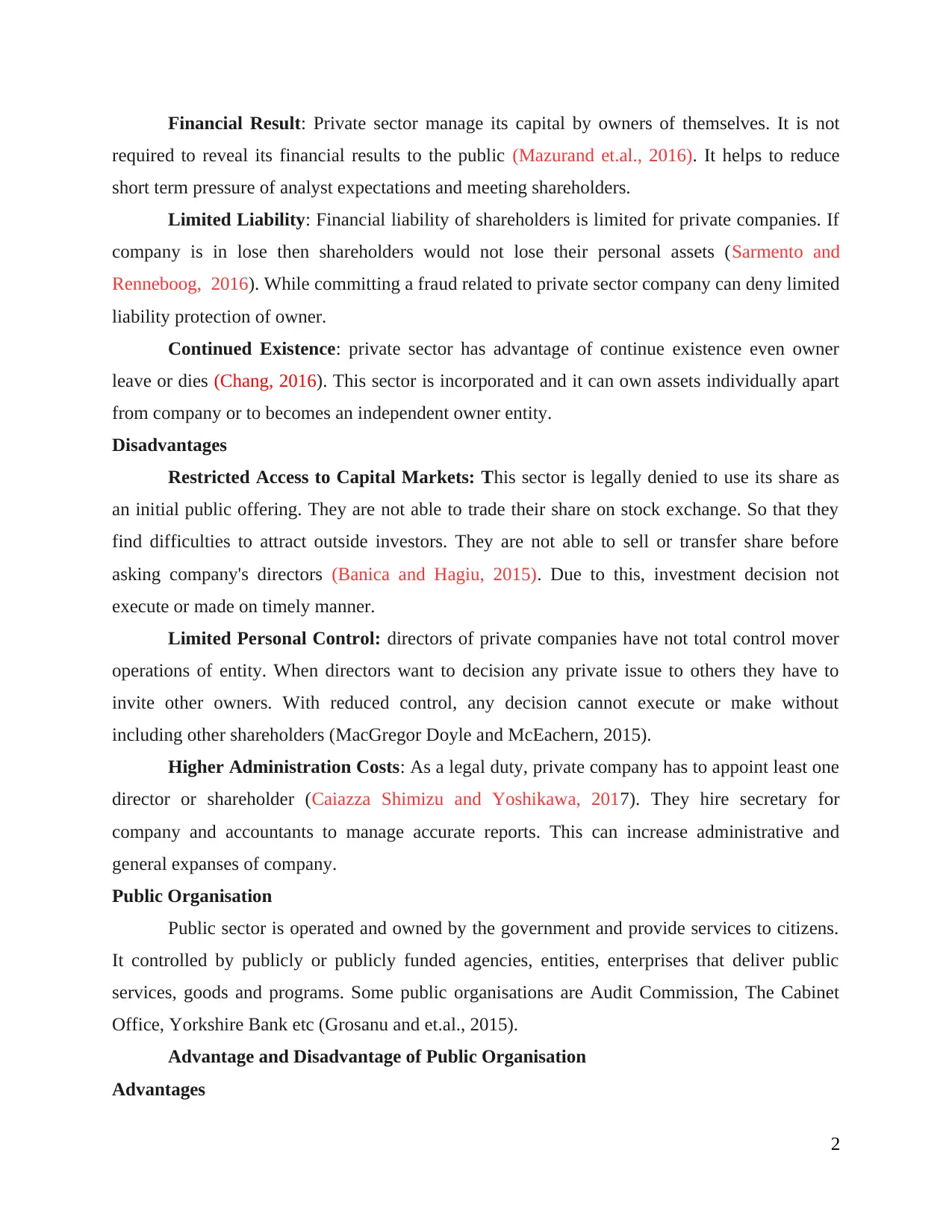
Financial Result: Private sector manage its capital by owners of themselves. It is not
required to reveal its financial results to the public (Mazurand et.al., 2016). It helps to reduce
short term pressure of analyst expectations and meeting shareholders.
Limited Liability: Financial liability of shareholders is limited for private companies. If
company is in lose then shareholders would not lose their personal assets (Sarmento and
Renneboog, 2016). While committing a fraud related to private sector company can deny limited
liability protection of owner.
Continued Existence: private sector has advantage of continue existence even owner
leave or dies (Chang, 2016). This sector is incorporated and it can own assets individually apart
from company or to becomes an independent owner entity.
Disadvantages
Restricted Access to Capital Markets: This sector is legally denied to use its share as
an initial public offering. They are not able to trade their share on stock exchange. So that they
find difficulties to attract outside investors. They are not able to sell or transfer share before
asking company's directors (Banica and Hagiu, 2015). Due to this, investment decision not
execute or made on timely manner.
Limited Personal Control: directors of private companies have not total control mover
operations of entity. When directors want to decision any private issue to others they have to
invite other owners. With reduced control, any decision cannot execute or make without
including other shareholders (MacGregor Doyle and McEachern, 2015).
Higher Administration Costs: As a legal duty, private company has to appoint least one
director or shareholder (Caiazza Shimizu and Yoshikawa, 2017). They hire secretary for
company and accountants to manage accurate reports. This can increase administrative and
general expanses of company.
Public Organisation
Public sector is operated and owned by the government and provide services to citizens.
It controlled by publicly or publicly funded agencies, entities, enterprises that deliver public
services, goods and programs. Some public organisations are Audit Commission, The Cabinet
Office, Yorkshire Bank etc (Grosanu and et.al., 2015).
Advantage and Disadvantage of Public Organisation
Advantages
2
required to reveal its financial results to the public (Mazurand et.al., 2016). It helps to reduce
short term pressure of analyst expectations and meeting shareholders.
Limited Liability: Financial liability of shareholders is limited for private companies. If
company is in lose then shareholders would not lose their personal assets (Sarmento and
Renneboog, 2016). While committing a fraud related to private sector company can deny limited
liability protection of owner.
Continued Existence: private sector has advantage of continue existence even owner
leave or dies (Chang, 2016). This sector is incorporated and it can own assets individually apart
from company or to becomes an independent owner entity.
Disadvantages
Restricted Access to Capital Markets: This sector is legally denied to use its share as
an initial public offering. They are not able to trade their share on stock exchange. So that they
find difficulties to attract outside investors. They are not able to sell or transfer share before
asking company's directors (Banica and Hagiu, 2015). Due to this, investment decision not
execute or made on timely manner.
Limited Personal Control: directors of private companies have not total control mover
operations of entity. When directors want to decision any private issue to others they have to
invite other owners. With reduced control, any decision cannot execute or make without
including other shareholders (MacGregor Doyle and McEachern, 2015).
Higher Administration Costs: As a legal duty, private company has to appoint least one
director or shareholder (Caiazza Shimizu and Yoshikawa, 2017). They hire secretary for
company and accountants to manage accurate reports. This can increase administrative and
general expanses of company.
Public Organisation
Public sector is operated and owned by the government and provide services to citizens.
It controlled by publicly or publicly funded agencies, entities, enterprises that deliver public
services, goods and programs. Some public organisations are Audit Commission, The Cabinet
Office, Yorkshire Bank etc (Grosanu and et.al., 2015).
Advantage and Disadvantage of Public Organisation
Advantages
2
Secure Best Marks with AI Grader
Need help grading? Try our AI Grader for instant feedback on your assignments.
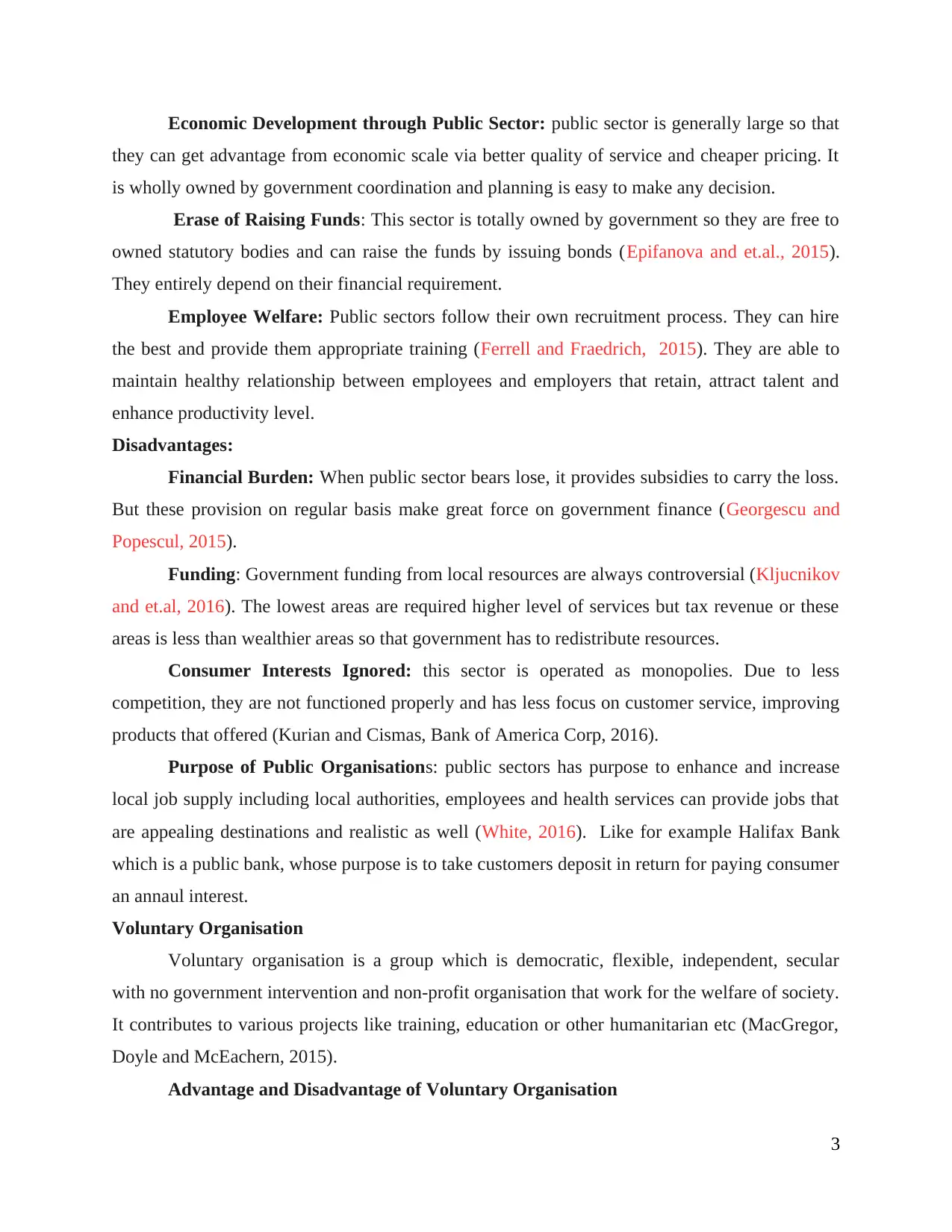
Economic Development through Public Sector: public sector is generally large so that
they can get advantage from economic scale via better quality of service and cheaper pricing. It
is wholly owned by government coordination and planning is easy to make any decision.
Erase of Raising Funds: This sector is totally owned by government so they are free to
owned statutory bodies and can raise the funds by issuing bonds (Epifanova and et.al., 2015).
They entirely depend on their financial requirement.
Employee Welfare: Public sectors follow their own recruitment process. They can hire
the best and provide them appropriate training (Ferrell and Fraedrich, 2015). They are able to
maintain healthy relationship between employees and employers that retain, attract talent and
enhance productivity level.
Disadvantages:
Financial Burden: When public sector bears lose, it provides subsidies to carry the loss.
But these provision on regular basis make great force on government finance (Georgescu and
Popescul, 2015).
Funding: Government funding from local resources are always controversial (Kljucnikov
and et.al, 2016). The lowest areas are required higher level of services but tax revenue or these
areas is less than wealthier areas so that government has to redistribute resources.
Consumer Interests Ignored: this sector is operated as monopolies. Due to less
competition, they are not functioned properly and has less focus on customer service, improving
products that offered (Kurian and Cismas, Bank of America Corp, 2016).
Purpose of Public Organisations: public sectors has purpose to enhance and increase
local job supply including local authorities, employees and health services can provide jobs that
are appealing destinations and realistic as well (White, 2016). Like for example Halifax Bank
which is a public bank, whose purpose is to take customers deposit in return for paying consumer
an annaul interest.
Voluntary Organisation
Voluntary organisation is a group which is democratic, flexible, independent, secular
with no government intervention and non-profit organisation that work for the welfare of society.
It contributes to various projects like training, education or other humanitarian etc (MacGregor,
Doyle and McEachern, 2015).
Advantage and Disadvantage of Voluntary Organisation
3
they can get advantage from economic scale via better quality of service and cheaper pricing. It
is wholly owned by government coordination and planning is easy to make any decision.
Erase of Raising Funds: This sector is totally owned by government so they are free to
owned statutory bodies and can raise the funds by issuing bonds (Epifanova and et.al., 2015).
They entirely depend on their financial requirement.
Employee Welfare: Public sectors follow their own recruitment process. They can hire
the best and provide them appropriate training (Ferrell and Fraedrich, 2015). They are able to
maintain healthy relationship between employees and employers that retain, attract talent and
enhance productivity level.
Disadvantages:
Financial Burden: When public sector bears lose, it provides subsidies to carry the loss.
But these provision on regular basis make great force on government finance (Georgescu and
Popescul, 2015).
Funding: Government funding from local resources are always controversial (Kljucnikov
and et.al, 2016). The lowest areas are required higher level of services but tax revenue or these
areas is less than wealthier areas so that government has to redistribute resources.
Consumer Interests Ignored: this sector is operated as monopolies. Due to less
competition, they are not functioned properly and has less focus on customer service, improving
products that offered (Kurian and Cismas, Bank of America Corp, 2016).
Purpose of Public Organisations: public sectors has purpose to enhance and increase
local job supply including local authorities, employees and health services can provide jobs that
are appealing destinations and realistic as well (White, 2016). Like for example Halifax Bank
which is a public bank, whose purpose is to take customers deposit in return for paying consumer
an annaul interest.
Voluntary Organisation
Voluntary organisation is a group which is democratic, flexible, independent, secular
with no government intervention and non-profit organisation that work for the welfare of society.
It contributes to various projects like training, education or other humanitarian etc (MacGregor,
Doyle and McEachern, 2015).
Advantage and Disadvantage of Voluntary Organisation
3
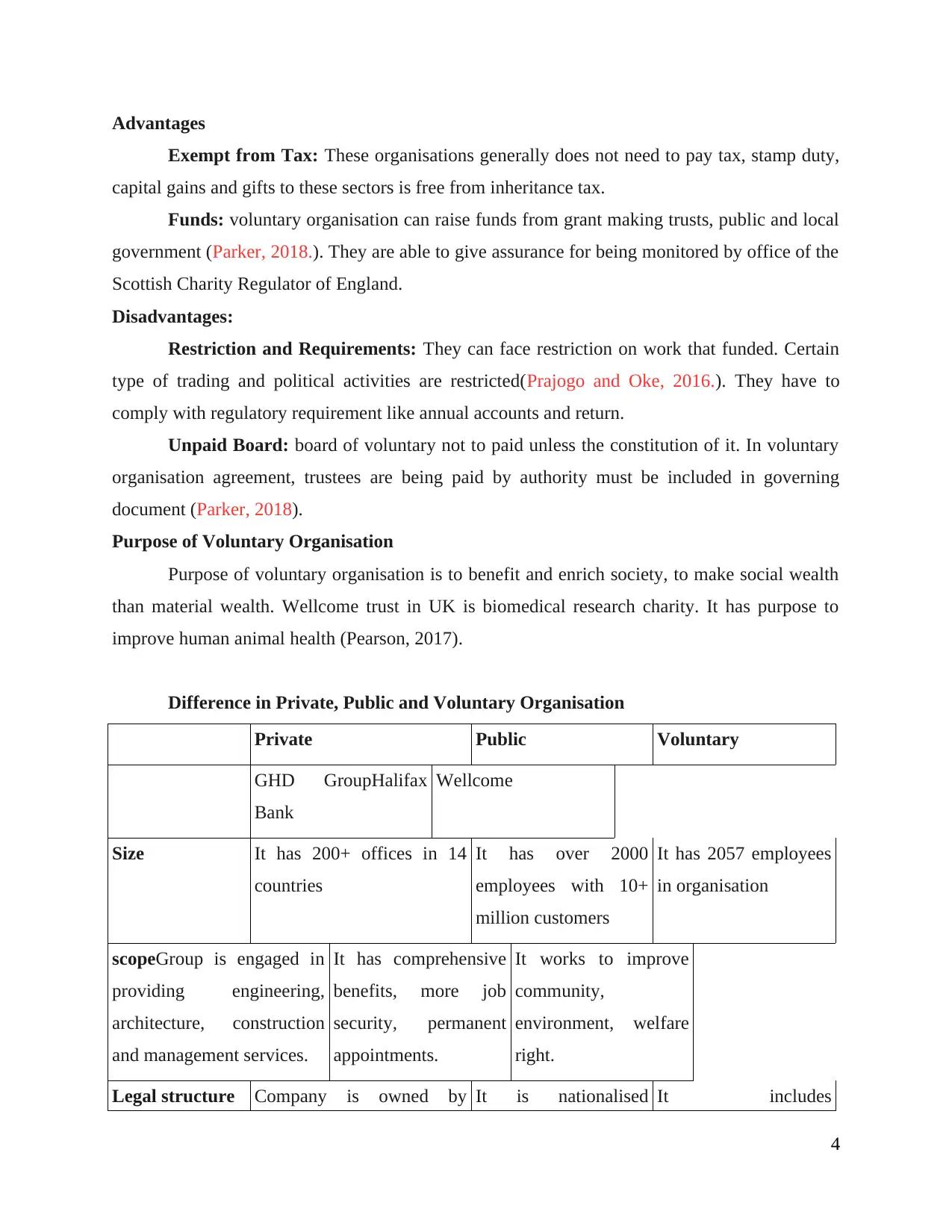
Advantages
Exempt from Tax: These organisations generally does not need to pay tax, stamp duty,
capital gains and gifts to these sectors is free from inheritance tax.
Funds: voluntary organisation can raise funds from grant making trusts, public and local
government (Parker, 2018.). They are able to give assurance for being monitored by office of the
Scottish Charity Regulator of England.
Disadvantages:
Restriction and Requirements: They can face restriction on work that funded. Certain
type of trading and political activities are restricted(Prajogo and Oke, 2016.). They have to
comply with regulatory requirement like annual accounts and return.
Unpaid Board: board of voluntary not to paid unless the constitution of it. In voluntary
organisation agreement, trustees are being paid by authority must be included in governing
document (Parker, 2018).
Purpose of Voluntary Organisation
Purpose of voluntary organisation is to benefit and enrich society, to make social wealth
than material wealth. Wellcome trust in UK is biomedical research charity. It has purpose to
improve human animal health (Pearson, 2017).
Difference in Private, Public and Voluntary Organisation
Private Public Voluntary
GHD GroupHalifax
Bank
Wellcome
Size It has 200+ offices in 14
countries
It has over 2000
employees with 10+
million customers
It has 2057 employees
in organisation
scopeGroup is engaged in
providing engineering,
architecture, construction
and management services.
It has comprehensive
benefits, more job
security, permanent
appointments.
It works to improve
community,
environment, welfare
right.
Legal structure Company is owned by It is nationalised It includes
4
Exempt from Tax: These organisations generally does not need to pay tax, stamp duty,
capital gains and gifts to these sectors is free from inheritance tax.
Funds: voluntary organisation can raise funds from grant making trusts, public and local
government (Parker, 2018.). They are able to give assurance for being monitored by office of the
Scottish Charity Regulator of England.
Disadvantages:
Restriction and Requirements: They can face restriction on work that funded. Certain
type of trading and political activities are restricted(Prajogo and Oke, 2016.). They have to
comply with regulatory requirement like annual accounts and return.
Unpaid Board: board of voluntary not to paid unless the constitution of it. In voluntary
organisation agreement, trustees are being paid by authority must be included in governing
document (Parker, 2018).
Purpose of Voluntary Organisation
Purpose of voluntary organisation is to benefit and enrich society, to make social wealth
than material wealth. Wellcome trust in UK is biomedical research charity. It has purpose to
improve human animal health (Pearson, 2017).
Difference in Private, Public and Voluntary Organisation
Private Public Voluntary
GHD GroupHalifax
Bank
Wellcome
Size It has 200+ offices in 14
countries
It has over 2000
employees with 10+
million customers
It has 2057 employees
in organisation
scopeGroup is engaged in
providing engineering,
architecture, construction
and management services.
It has comprehensive
benefits, more job
security, permanent
appointments.
It works to improve
community,
environment, welfare
right.
Legal structure Company is owned by It is nationalised It includes
4
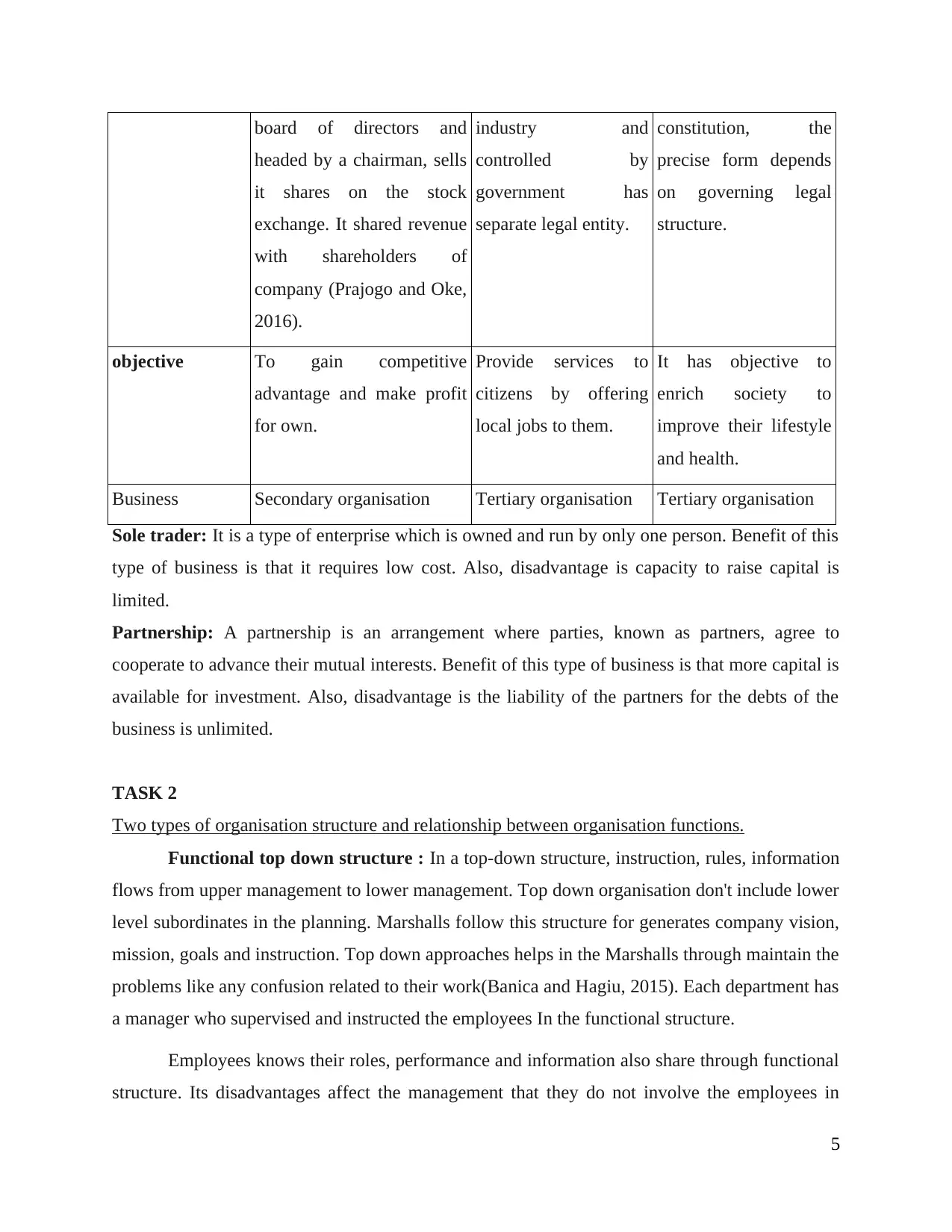
board of directors and
headed by a chairman, sells
it shares on the stock
exchange. It shared revenue
with shareholders of
company (Prajogo and Oke,
2016).
industry and
controlled by
government has
separate legal entity.
constitution, the
precise form depends
on governing legal
structure.
objective To gain competitive
advantage and make profit
for own.
Provide services to
citizens by offering
local jobs to them.
It has objective to
enrich society to
improve their lifestyle
and health.
Business Secondary organisation Tertiary organisation Tertiary organisation
Sole trader: It is a type of enterprise which is owned and run by only one person. Benefit of this
type of business is that it requires low cost. Also, disadvantage is capacity to raise capital is
limited.
Partnership: A partnership is an arrangement where parties, known as partners, agree to
cooperate to advance their mutual interests. Benefit of this type of business is that more capital is
available for investment. Also, disadvantage is the liability of the partners for the debts of the
business is unlimited.
TASK 2
Two types of organisation structure and relationship between organisation functions.
Functional top down structure : In a top-down structure, instruction, rules, information
flows from upper management to lower management. Top down organisation don't include lower
level subordinates in the planning. Marshalls follow this structure for generates company vision,
mission, goals and instruction. Top down approaches helps in the Marshalls through maintain the
problems like any confusion related to their work(Banica and Hagiu, 2015). Each department has
a manager who supervised and instructed the employees In the functional structure.
Employees knows their roles, performance and information also share through functional
structure. Its disadvantages affect the management that they do not involve the employees in
5
headed by a chairman, sells
it shares on the stock
exchange. It shared revenue
with shareholders of
company (Prajogo and Oke,
2016).
industry and
controlled by
government has
separate legal entity.
constitution, the
precise form depends
on governing legal
structure.
objective To gain competitive
advantage and make profit
for own.
Provide services to
citizens by offering
local jobs to them.
It has objective to
enrich society to
improve their lifestyle
and health.
Business Secondary organisation Tertiary organisation Tertiary organisation
Sole trader: It is a type of enterprise which is owned and run by only one person. Benefit of this
type of business is that it requires low cost. Also, disadvantage is capacity to raise capital is
limited.
Partnership: A partnership is an arrangement where parties, known as partners, agree to
cooperate to advance their mutual interests. Benefit of this type of business is that more capital is
available for investment. Also, disadvantage is the liability of the partners for the debts of the
business is unlimited.
TASK 2
Two types of organisation structure and relationship between organisation functions.
Functional top down structure : In a top-down structure, instruction, rules, information
flows from upper management to lower management. Top down organisation don't include lower
level subordinates in the planning. Marshalls follow this structure for generates company vision,
mission, goals and instruction. Top down approaches helps in the Marshalls through maintain the
problems like any confusion related to their work(Banica and Hagiu, 2015). Each department has
a manager who supervised and instructed the employees In the functional structure.
Employees knows their roles, performance and information also share through functional
structure. Its disadvantages affect the management that they do not involve the employees in
5
Paraphrase This Document
Need a fresh take? Get an instant paraphrase of this document with our AI Paraphraser
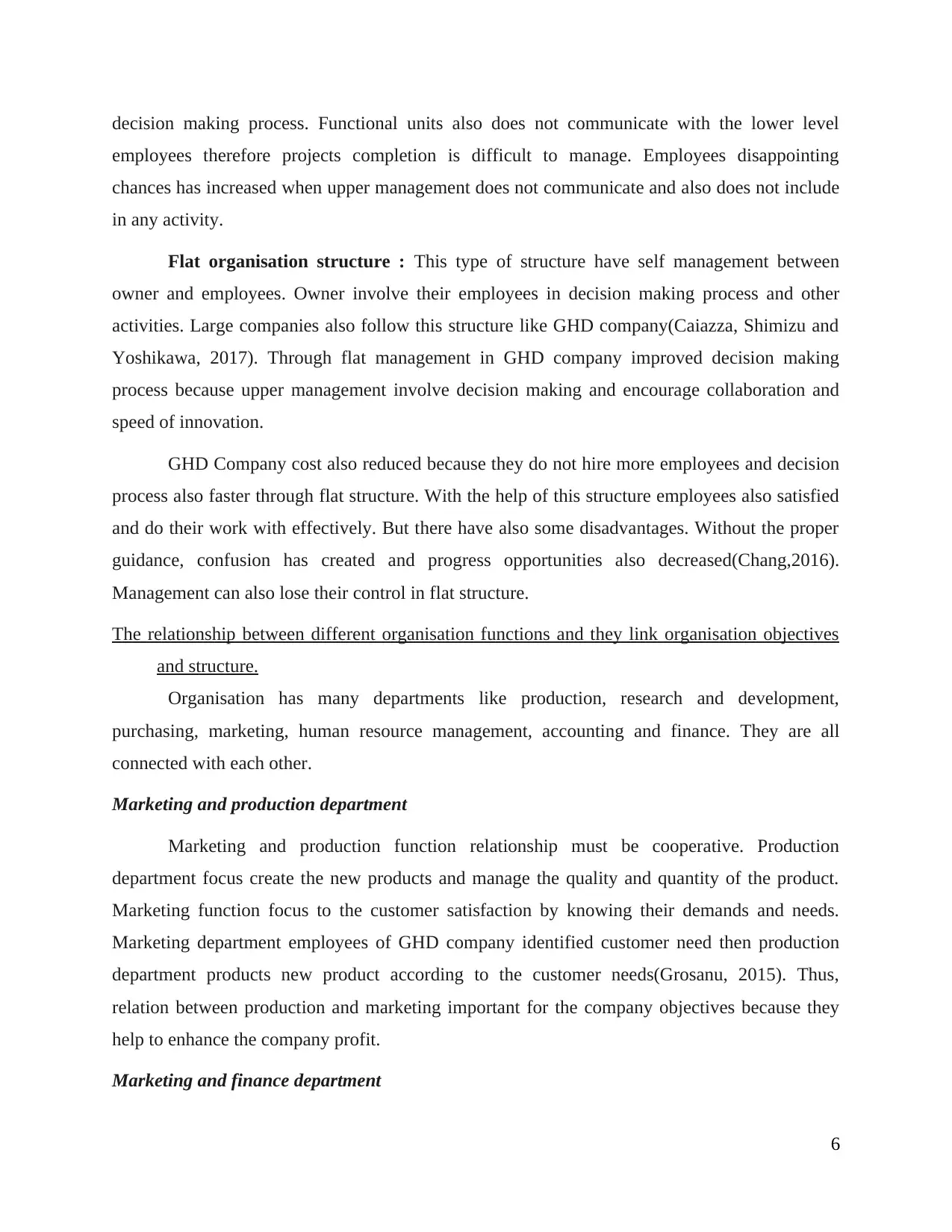
decision making process. Functional units also does not communicate with the lower level
employees therefore projects completion is difficult to manage. Employees disappointing
chances has increased when upper management does not communicate and also does not include
in any activity.
Flat organisation structure : This type of structure have self management between
owner and employees. Owner involve their employees in decision making process and other
activities. Large companies also follow this structure like GHD company(Caiazza, Shimizu and
Yoshikawa, 2017). Through flat management in GHD company improved decision making
process because upper management involve decision making and encourage collaboration and
speed of innovation.
GHD Company cost also reduced because they do not hire more employees and decision
process also faster through flat structure. With the help of this structure employees also satisfied
and do their work with effectively. But there have also some disadvantages. Without the proper
guidance, confusion has created and progress opportunities also decreased(Chang,2016).
Management can also lose their control in flat structure.
The relationship between different organisation functions and they link organisation objectives
and structure.
Organisation has many departments like production, research and development,
purchasing, marketing, human resource management, accounting and finance. They are all
connected with each other.
Marketing and production department
Marketing and production function relationship must be cooperative. Production
department focus create the new products and manage the quality and quantity of the product.
Marketing function focus to the customer satisfaction by knowing their demands and needs.
Marketing department employees of GHD company identified customer need then production
department products new product according to the customer needs(Grosanu, 2015). Thus,
relation between production and marketing important for the company objectives because they
help to enhance the company profit.
Marketing and finance department
6
employees therefore projects completion is difficult to manage. Employees disappointing
chances has increased when upper management does not communicate and also does not include
in any activity.
Flat organisation structure : This type of structure have self management between
owner and employees. Owner involve their employees in decision making process and other
activities. Large companies also follow this structure like GHD company(Caiazza, Shimizu and
Yoshikawa, 2017). Through flat management in GHD company improved decision making
process because upper management involve decision making and encourage collaboration and
speed of innovation.
GHD Company cost also reduced because they do not hire more employees and decision
process also faster through flat structure. With the help of this structure employees also satisfied
and do their work with effectively. But there have also some disadvantages. Without the proper
guidance, confusion has created and progress opportunities also decreased(Chang,2016).
Management can also lose their control in flat structure.
The relationship between different organisation functions and they link organisation objectives
and structure.
Organisation has many departments like production, research and development,
purchasing, marketing, human resource management, accounting and finance. They are all
connected with each other.
Marketing and production department
Marketing and production function relationship must be cooperative. Production
department focus create the new products and manage the quality and quantity of the product.
Marketing function focus to the customer satisfaction by knowing their demands and needs.
Marketing department employees of GHD company identified customer need then production
department products new product according to the customer needs(Grosanu, 2015). Thus,
relation between production and marketing important for the company objectives because they
help to enhance the company profit.
Marketing and finance department
6
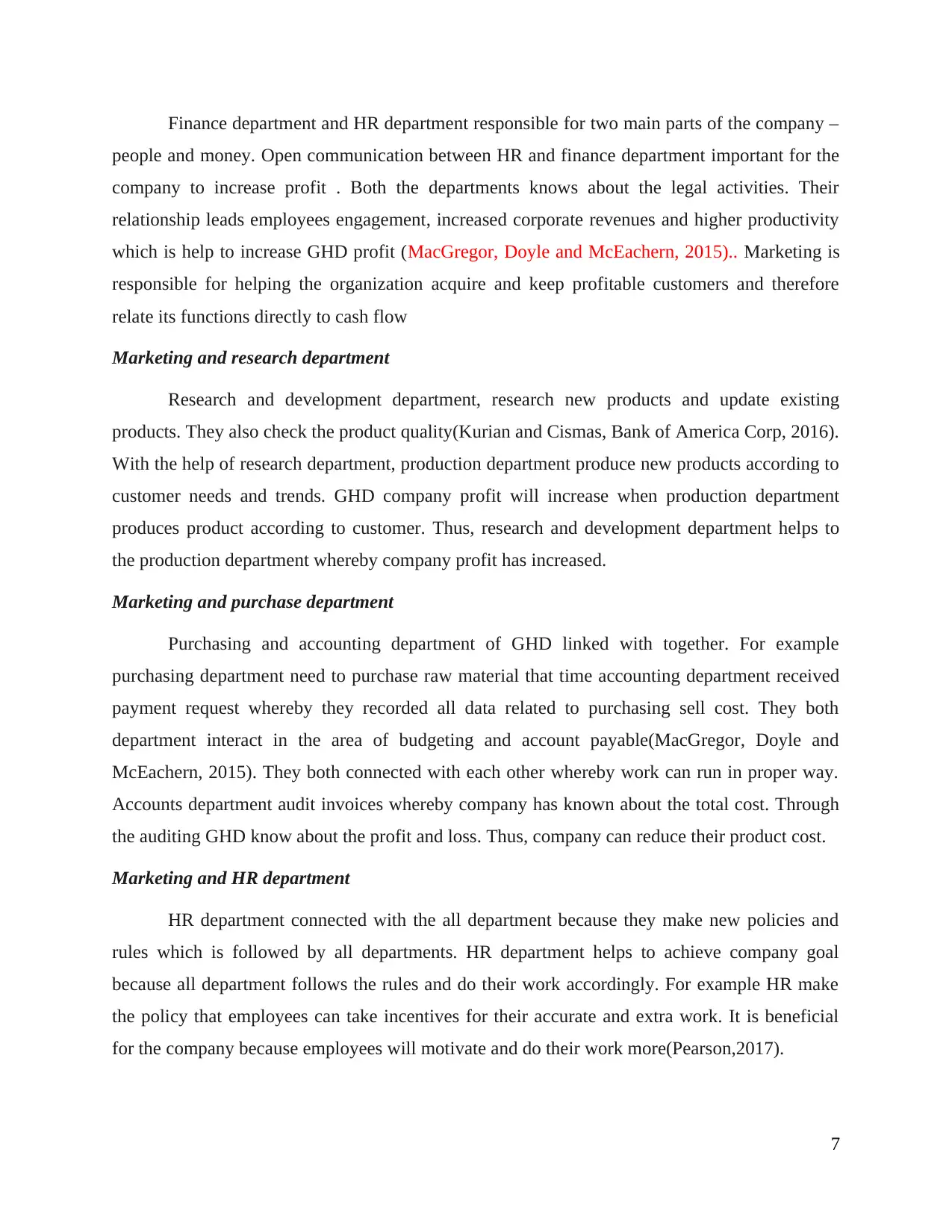
Finance department and HR department responsible for two main parts of the company –
people and money. Open communication between HR and finance department important for the
company to increase profit . Both the departments knows about the legal activities. Their
relationship leads employees engagement, increased corporate revenues and higher productivity
which is help to increase GHD profit (MacGregor, Doyle and McEachern, 2015).. Marketing is
responsible for helping the organization acquire and keep profitable customers and therefore
relate its functions directly to cash flow
Marketing and research department
Research and development department, research new products and update existing
products. They also check the product quality(Kurian and Cismas, Bank of America Corp, 2016).
With the help of research department, production department produce new products according to
customer needs and trends. GHD company profit will increase when production department
produces product according to customer. Thus, research and development department helps to
the production department whereby company profit has increased.
Marketing and purchase department
Purchasing and accounting department of GHD linked with together. For example
purchasing department need to purchase raw material that time accounting department received
payment request whereby they recorded all data related to purchasing sell cost. They both
department interact in the area of budgeting and account payable(MacGregor, Doyle and
McEachern, 2015). They both connected with each other whereby work can run in proper way.
Accounts department audit invoices whereby company has known about the total cost. Through
the auditing GHD know about the profit and loss. Thus, company can reduce their product cost.
Marketing and HR department
HR department connected with the all department because they make new policies and
rules which is followed by all departments. HR department helps to achieve company goal
because all department follows the rules and do their work accordingly. For example HR make
the policy that employees can take incentives for their accurate and extra work. It is beneficial
for the company because employees will motivate and do their work more(Pearson,2017).
7
people and money. Open communication between HR and finance department important for the
company to increase profit . Both the departments knows about the legal activities. Their
relationship leads employees engagement, increased corporate revenues and higher productivity
which is help to increase GHD profit (MacGregor, Doyle and McEachern, 2015).. Marketing is
responsible for helping the organization acquire and keep profitable customers and therefore
relate its functions directly to cash flow
Marketing and research department
Research and development department, research new products and update existing
products. They also check the product quality(Kurian and Cismas, Bank of America Corp, 2016).
With the help of research department, production department produce new products according to
customer needs and trends. GHD company profit will increase when production department
produces product according to customer. Thus, research and development department helps to
the production department whereby company profit has increased.
Marketing and purchase department
Purchasing and accounting department of GHD linked with together. For example
purchasing department need to purchase raw material that time accounting department received
payment request whereby they recorded all data related to purchasing sell cost. They both
department interact in the area of budgeting and account payable(MacGregor, Doyle and
McEachern, 2015). They both connected with each other whereby work can run in proper way.
Accounts department audit invoices whereby company has known about the total cost. Through
the auditing GHD know about the profit and loss. Thus, company can reduce their product cost.
Marketing and HR department
HR department connected with the all department because they make new policies and
rules which is followed by all departments. HR department helps to achieve company goal
because all department follows the rules and do their work accordingly. For example HR make
the policy that employees can take incentives for their accurate and extra work. It is beneficial
for the company because employees will motivate and do their work more(Pearson,2017).
7
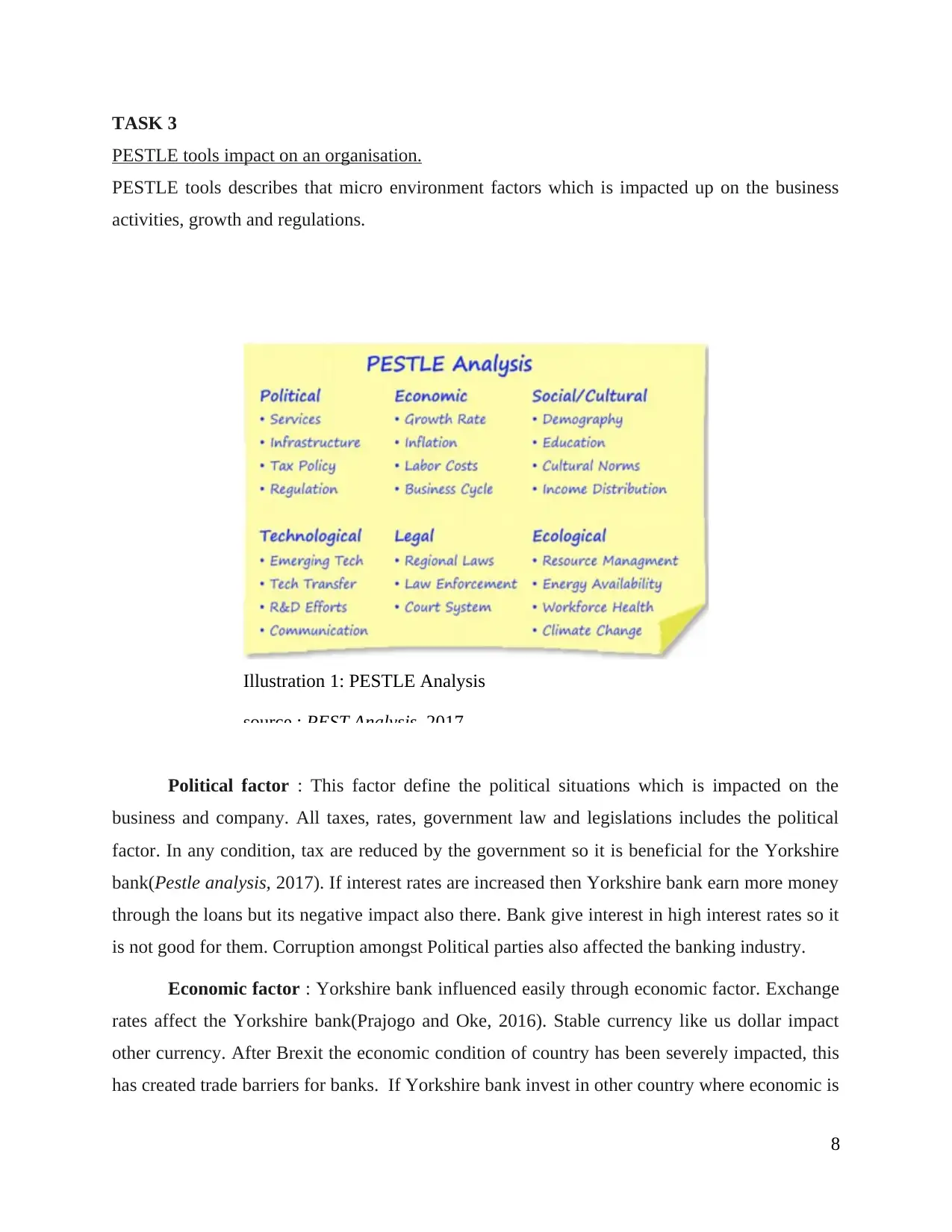
TASK 3
PESTLE tools impact on an organisation.
PESTLE tools describes that micro environment factors which is impacted up on the business
activities, growth and regulations.
Political factor : This factor define the political situations which is impacted on the
business and company. All taxes, rates, government law and legislations includes the political
factor. In any condition, tax are reduced by the government so it is beneficial for the Yorkshire
bank(Pestle analysis, 2017). If interest rates are increased then Yorkshire bank earn more money
through the loans but its negative impact also there. Bank give interest in high interest rates so it
is not good for them. Corruption amongst Political parties also affected the banking industry.
Economic factor : Yorkshire bank influenced easily through economic factor. Exchange
rates affect the Yorkshire bank(Prajogo and Oke, 2016). Stable currency like us dollar impact
other currency. After Brexit the economic condition of country has been severely impacted, this
has created trade barriers for banks. If Yorkshire bank invest in other country where economic is
8
Illustration 1: PESTLE Analysis
source : PEST Analysis, 2017
PESTLE tools impact on an organisation.
PESTLE tools describes that micro environment factors which is impacted up on the business
activities, growth and regulations.
Political factor : This factor define the political situations which is impacted on the
business and company. All taxes, rates, government law and legislations includes the political
factor. In any condition, tax are reduced by the government so it is beneficial for the Yorkshire
bank(Pestle analysis, 2017). If interest rates are increased then Yorkshire bank earn more money
through the loans but its negative impact also there. Bank give interest in high interest rates so it
is not good for them. Corruption amongst Political parties also affected the banking industry.
Economic factor : Yorkshire bank influenced easily through economic factor. Exchange
rates affect the Yorkshire bank(Prajogo and Oke, 2016). Stable currency like us dollar impact
other currency. After Brexit the economic condition of country has been severely impacted, this
has created trade barriers for banks. If Yorkshire bank invest in other country where economic is
8
Illustration 1: PESTLE Analysis
source : PEST Analysis, 2017
Secure Best Marks with AI Grader
Need help grading? Try our AI Grader for instant feedback on your assignments.
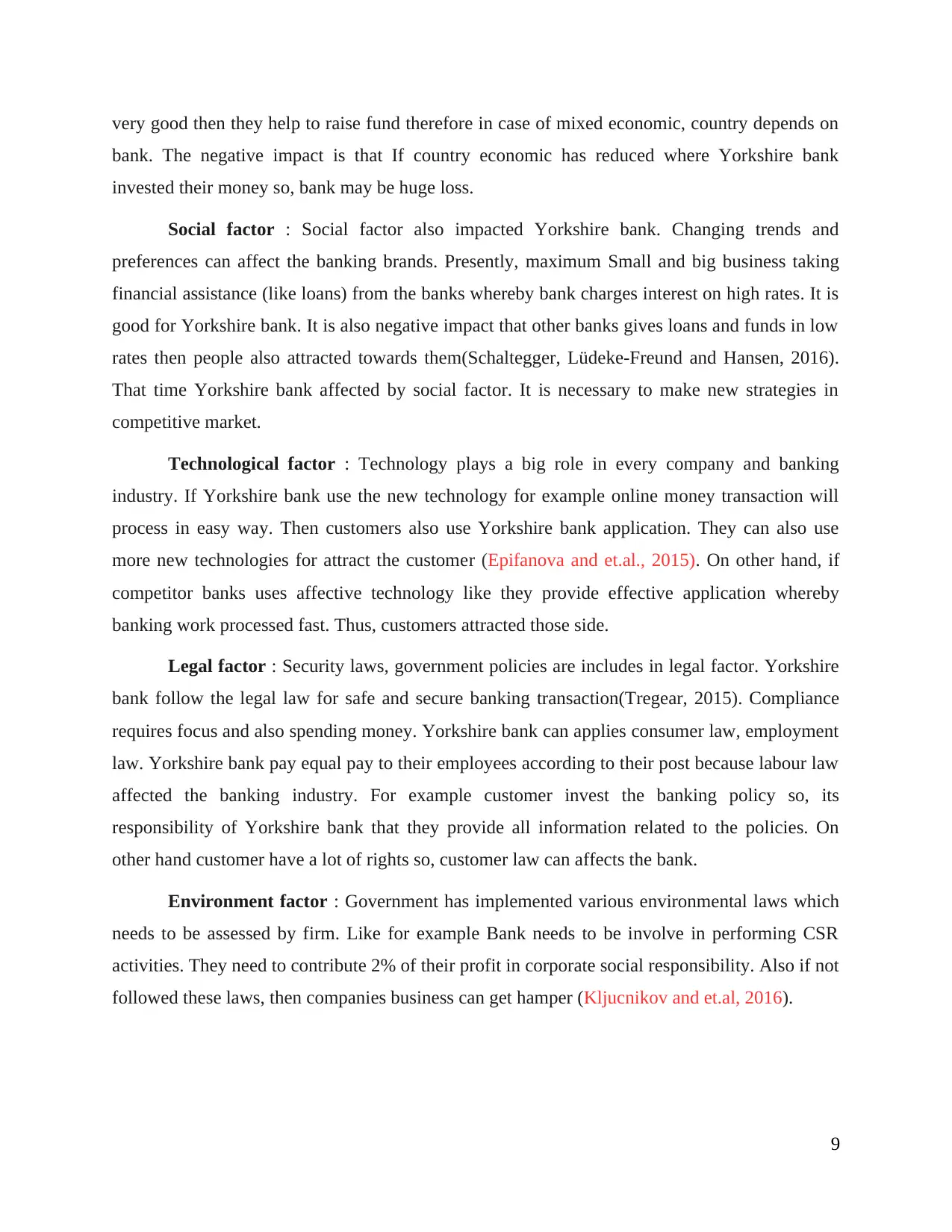
very good then they help to raise fund therefore in case of mixed economic, country depends on
bank. The negative impact is that If country economic has reduced where Yorkshire bank
invested their money so, bank may be huge loss.
Social factor : Social factor also impacted Yorkshire bank. Changing trends and
preferences can affect the banking brands. Presently, maximum Small and big business taking
financial assistance (like loans) from the banks whereby bank charges interest on high rates. It is
good for Yorkshire bank. It is also negative impact that other banks gives loans and funds in low
rates then people also attracted towards them(Schaltegger, Lüdeke-Freund and Hansen, 2016).
That time Yorkshire bank affected by social factor. It is necessary to make new strategies in
competitive market.
Technological factor : Technology plays a big role in every company and banking
industry. If Yorkshire bank use the new technology for example online money transaction will
process in easy way. Then customers also use Yorkshire bank application. They can also use
more new technologies for attract the customer (Epifanova and et.al., 2015). On other hand, if
competitor banks uses affective technology like they provide effective application whereby
banking work processed fast. Thus, customers attracted those side.
Legal factor : Security laws, government policies are includes in legal factor. Yorkshire
bank follow the legal law for safe and secure banking transaction(Tregear, 2015). Compliance
requires focus and also spending money. Yorkshire bank can applies consumer law, employment
law. Yorkshire bank pay equal pay to their employees according to their post because labour law
affected the banking industry. For example customer invest the banking policy so, its
responsibility of Yorkshire bank that they provide all information related to the policies. On
other hand customer have a lot of rights so, customer law can affects the bank.
Environment factor : Government has implemented various environmental laws which
needs to be assessed by firm. Like for example Bank needs to be involve in performing CSR
activities. They need to contribute 2% of their profit in corporate social responsibility. Also if not
followed these laws, then companies business can get hamper (Kljucnikov and et.al, 2016).
9
bank. The negative impact is that If country economic has reduced where Yorkshire bank
invested their money so, bank may be huge loss.
Social factor : Social factor also impacted Yorkshire bank. Changing trends and
preferences can affect the banking brands. Presently, maximum Small and big business taking
financial assistance (like loans) from the banks whereby bank charges interest on high rates. It is
good for Yorkshire bank. It is also negative impact that other banks gives loans and funds in low
rates then people also attracted towards them(Schaltegger, Lüdeke-Freund and Hansen, 2016).
That time Yorkshire bank affected by social factor. It is necessary to make new strategies in
competitive market.
Technological factor : Technology plays a big role in every company and banking
industry. If Yorkshire bank use the new technology for example online money transaction will
process in easy way. Then customers also use Yorkshire bank application. They can also use
more new technologies for attract the customer (Epifanova and et.al., 2015). On other hand, if
competitor banks uses affective technology like they provide effective application whereby
banking work processed fast. Thus, customers attracted those side.
Legal factor : Security laws, government policies are includes in legal factor. Yorkshire
bank follow the legal law for safe and secure banking transaction(Tregear, 2015). Compliance
requires focus and also spending money. Yorkshire bank can applies consumer law, employment
law. Yorkshire bank pay equal pay to their employees according to their post because labour law
affected the banking industry. For example customer invest the banking policy so, its
responsibility of Yorkshire bank that they provide all information related to the policies. On
other hand customer have a lot of rights so, customer law can affects the bank.
Environment factor : Government has implemented various environmental laws which
needs to be assessed by firm. Like for example Bank needs to be involve in performing CSR
activities. They need to contribute 2% of their profit in corporate social responsibility. Also if not
followed these laws, then companies business can get hamper (Kljucnikov and et.al, 2016).
9
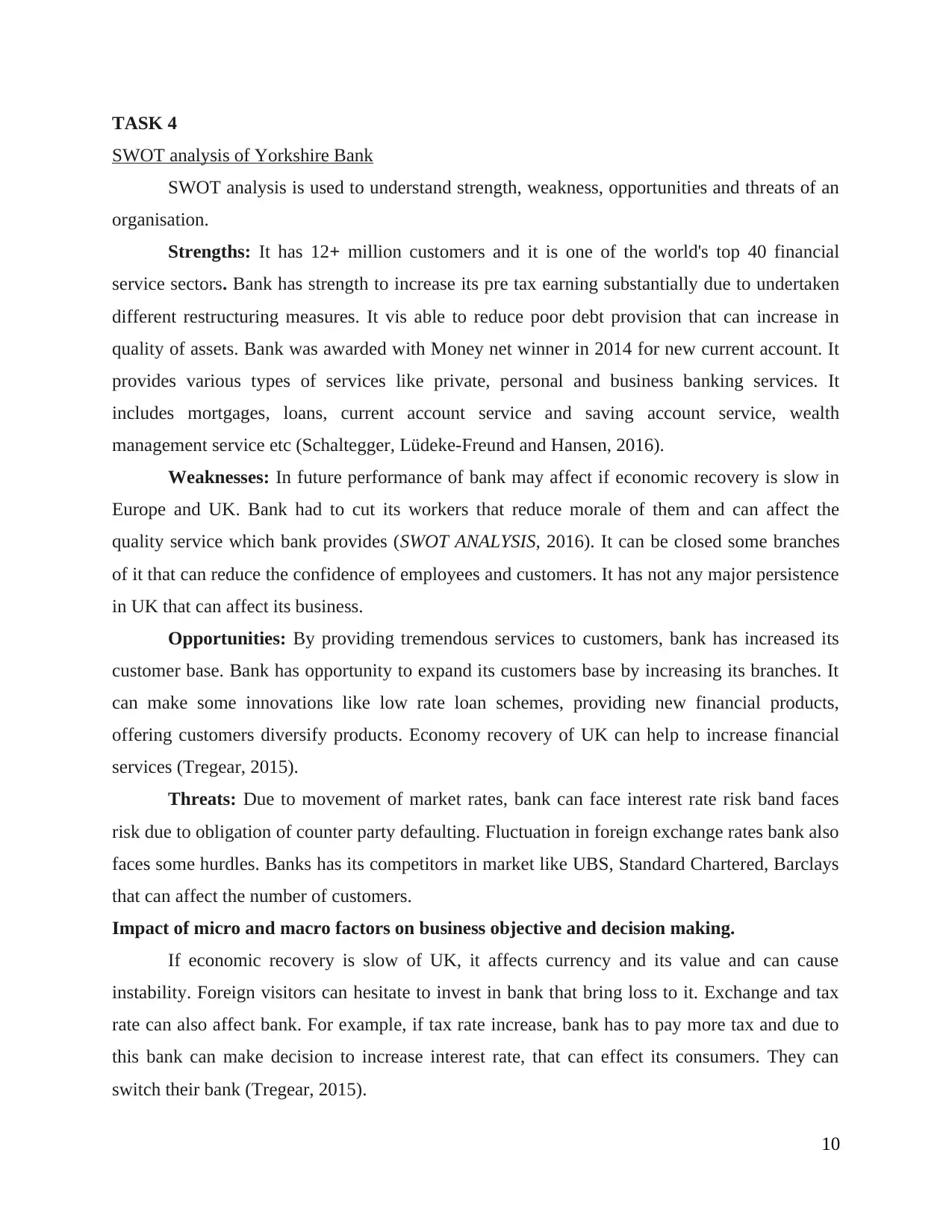
TASK 4
SWOT analysis of Yorkshire Bank
SWOT analysis is used to understand strength, weakness, opportunities and threats of an
organisation.
Strengths: It has 12+ million customers and it is one of the world's top 40 financial
service sectors. Bank has strength to increase its pre tax earning substantially due to undertaken
different restructuring measures. It vis able to reduce poor debt provision that can increase in
quality of assets. Bank was awarded with Money net winner in 2014 for new current account. It
provides various types of services like private, personal and business banking services. It
includes mortgages, loans, current account service and saving account service, wealth
management service etc (Schaltegger, Lüdeke-Freund and Hansen, 2016).
Weaknesses: In future performance of bank may affect if economic recovery is slow in
Europe and UK. Bank had to cut its workers that reduce morale of them and can affect the
quality service which bank provides (SWOT ANALYSIS, 2016). It can be closed some branches
of it that can reduce the confidence of employees and customers. It has not any major persistence
in UK that can affect its business.
Opportunities: By providing tremendous services to customers, bank has increased its
customer base. Bank has opportunity to expand its customers base by increasing its branches. It
can make some innovations like low rate loan schemes, providing new financial products,
offering customers diversify products. Economy recovery of UK can help to increase financial
services (Tregear, 2015).
Threats: Due to movement of market rates, bank can face interest rate risk band faces
risk due to obligation of counter party defaulting. Fluctuation in foreign exchange rates bank also
faces some hurdles. Banks has its competitors in market like UBS, Standard Chartered, Barclays
that can affect the number of customers.
Impact of micro and macro factors on business objective and decision making.
If economic recovery is slow of UK, it affects currency and its value and can cause
instability. Foreign visitors can hesitate to invest in bank that bring loss to it. Exchange and tax
rate can also affect bank. For example, if tax rate increase, bank has to pay more tax and due to
this bank can make decision to increase interest rate, that can effect its consumers. They can
switch their bank (Tregear, 2015).
10
SWOT analysis of Yorkshire Bank
SWOT analysis is used to understand strength, weakness, opportunities and threats of an
organisation.
Strengths: It has 12+ million customers and it is one of the world's top 40 financial
service sectors. Bank has strength to increase its pre tax earning substantially due to undertaken
different restructuring measures. It vis able to reduce poor debt provision that can increase in
quality of assets. Bank was awarded with Money net winner in 2014 for new current account. It
provides various types of services like private, personal and business banking services. It
includes mortgages, loans, current account service and saving account service, wealth
management service etc (Schaltegger, Lüdeke-Freund and Hansen, 2016).
Weaknesses: In future performance of bank may affect if economic recovery is slow in
Europe and UK. Bank had to cut its workers that reduce morale of them and can affect the
quality service which bank provides (SWOT ANALYSIS, 2016). It can be closed some branches
of it that can reduce the confidence of employees and customers. It has not any major persistence
in UK that can affect its business.
Opportunities: By providing tremendous services to customers, bank has increased its
customer base. Bank has opportunity to expand its customers base by increasing its branches. It
can make some innovations like low rate loan schemes, providing new financial products,
offering customers diversify products. Economy recovery of UK can help to increase financial
services (Tregear, 2015).
Threats: Due to movement of market rates, bank can face interest rate risk band faces
risk due to obligation of counter party defaulting. Fluctuation in foreign exchange rates bank also
faces some hurdles. Banks has its competitors in market like UBS, Standard Chartered, Barclays
that can affect the number of customers.
Impact of micro and macro factors on business objective and decision making.
If economic recovery is slow of UK, it affects currency and its value and can cause
instability. Foreign visitors can hesitate to invest in bank that bring loss to it. Exchange and tax
rate can also affect bank. For example, if tax rate increase, bank has to pay more tax and due to
this bank can make decision to increase interest rate, that can effect its consumers. They can
switch their bank (Tregear, 2015).
10
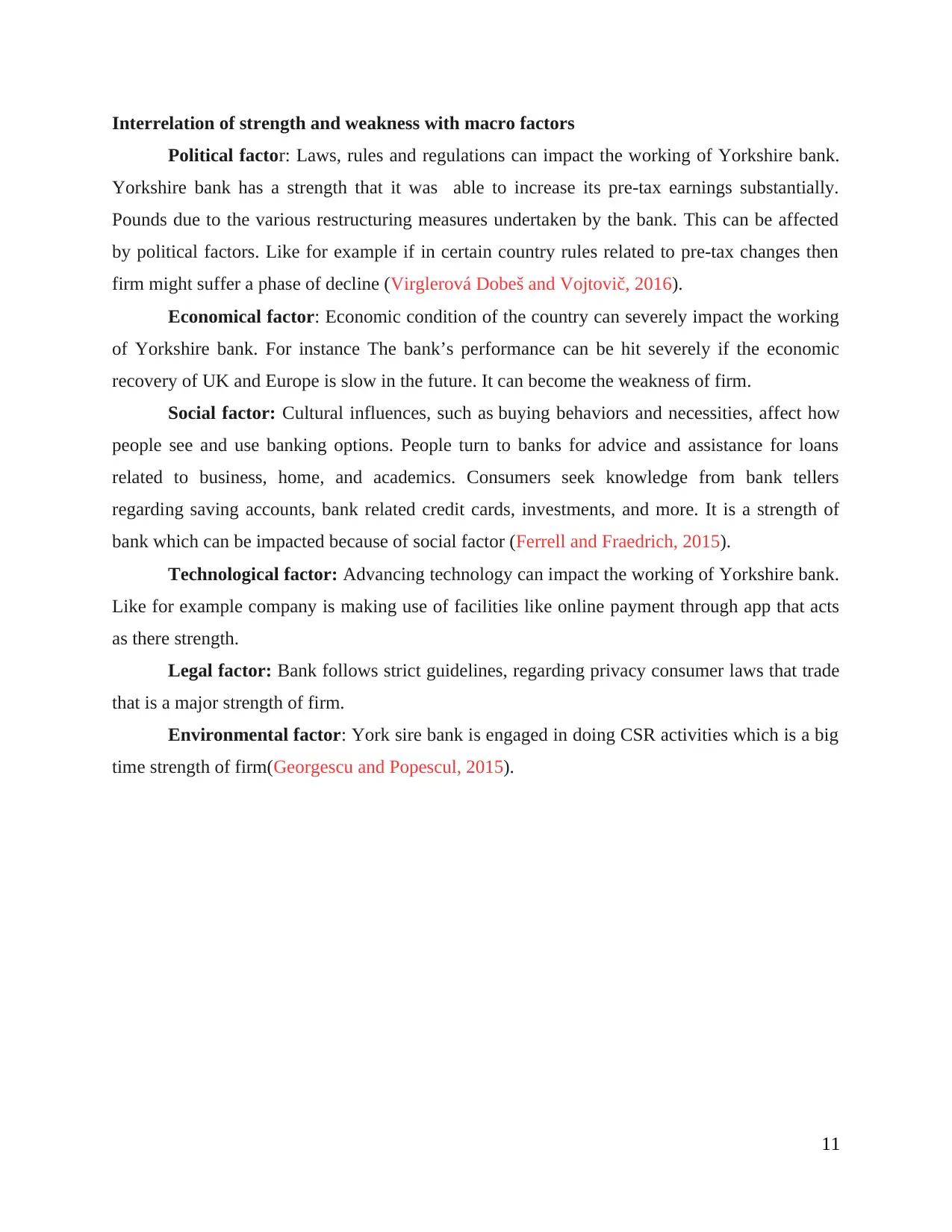
Interrelation of strength and weakness with macro factors
Political factor: Laws, rules and regulations can impact the working of Yorkshire bank.
Yorkshire bank has a strength that it was able to increase its pre-tax earnings substantially.
Pounds due to the various restructuring measures undertaken by the bank. This can be affected
by political factors. Like for example if in certain country rules related to pre-tax changes then
firm might suffer a phase of decline (Virglerová Dobeš and Vojtovič, 2016).
Economical factor: Economic condition of the country can severely impact the working
of Yorkshire bank. For instance The bank’s performance can be hit severely if the economic
recovery of UK and Europe is slow in the future. It can become the weakness of firm.
Social factor: Cultural influences, such as buying behaviors and necessities, affect how
people see and use banking options. People turn to banks for advice and assistance for loans
related to business, home, and academics. Consumers seek knowledge from bank tellers
regarding saving accounts, bank related credit cards, investments, and more. It is a strength of
bank which can be impacted because of social factor (Ferrell and Fraedrich, 2015).
Technological factor: Advancing technology can impact the working of Yorkshire bank.
Like for example company is making use of facilities like online payment through app that acts
as there strength.
Legal factor: Bank follows strict guidelines, regarding privacy consumer laws that trade
that is a major strength of firm.
Environmental factor: York sire bank is engaged in doing CSR activities which is a big
time strength of firm(Georgescu and Popescul, 2015).
11
Political factor: Laws, rules and regulations can impact the working of Yorkshire bank.
Yorkshire bank has a strength that it was able to increase its pre-tax earnings substantially.
Pounds due to the various restructuring measures undertaken by the bank. This can be affected
by political factors. Like for example if in certain country rules related to pre-tax changes then
firm might suffer a phase of decline (Virglerová Dobeš and Vojtovič, 2016).
Economical factor: Economic condition of the country can severely impact the working
of Yorkshire bank. For instance The bank’s performance can be hit severely if the economic
recovery of UK and Europe is slow in the future. It can become the weakness of firm.
Social factor: Cultural influences, such as buying behaviors and necessities, affect how
people see and use banking options. People turn to banks for advice and assistance for loans
related to business, home, and academics. Consumers seek knowledge from bank tellers
regarding saving accounts, bank related credit cards, investments, and more. It is a strength of
bank which can be impacted because of social factor (Ferrell and Fraedrich, 2015).
Technological factor: Advancing technology can impact the working of Yorkshire bank.
Like for example company is making use of facilities like online payment through app that acts
as there strength.
Legal factor: Bank follows strict guidelines, regarding privacy consumer laws that trade
that is a major strength of firm.
Environmental factor: York sire bank is engaged in doing CSR activities which is a big
time strength of firm(Georgescu and Popescul, 2015).
11
Paraphrase This Document
Need a fresh take? Get an instant paraphrase of this document with our AI Paraphraser
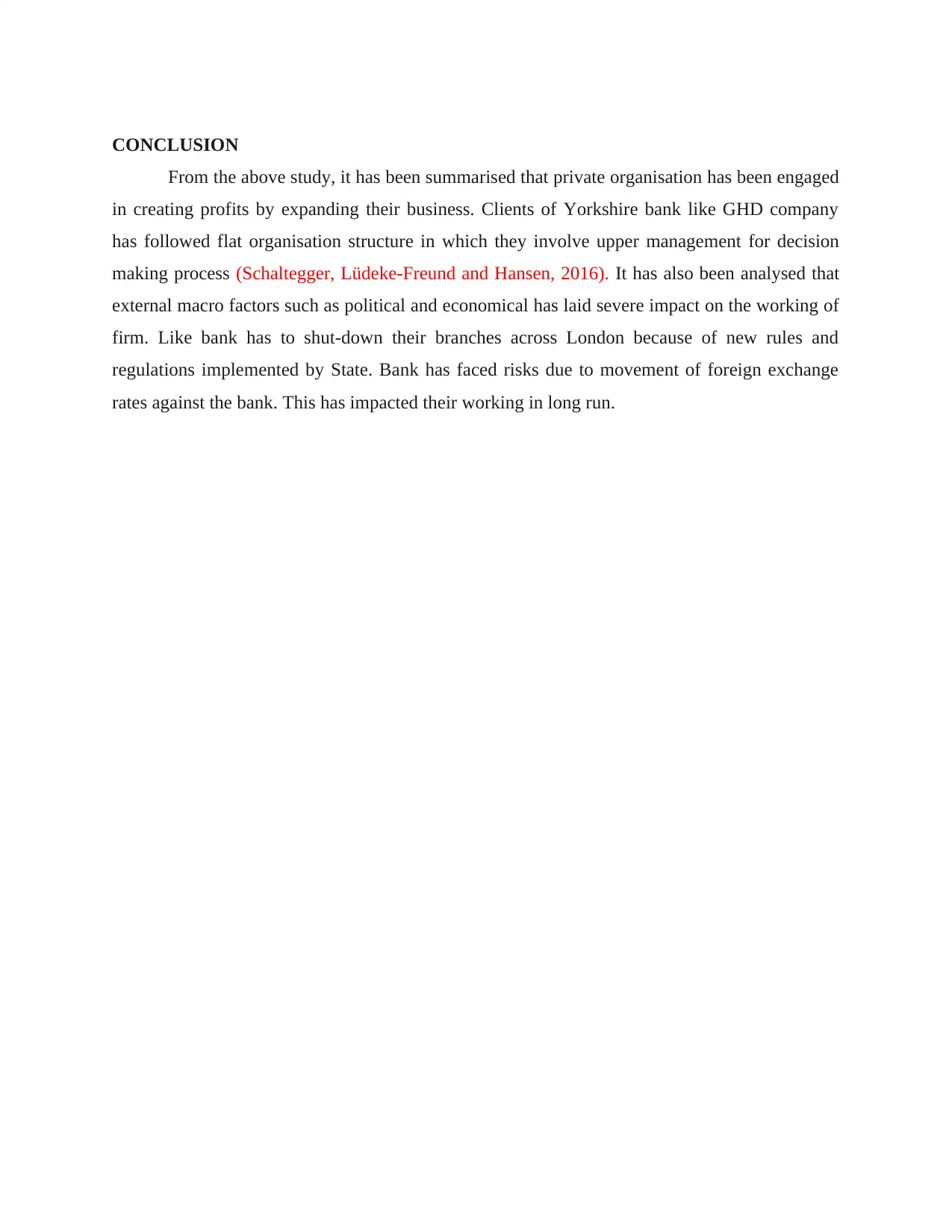
CONCLUSION
From the above study, it has been summarised that private organisation has been engaged
in creating profits by expanding their business. Clients of Yorkshire bank like GHD company
has followed flat organisation structure in which they involve upper management for decision
making process (Schaltegger, Lüdeke-Freund and Hansen, 2016). It has also been analysed that
external macro factors such as political and economical has laid severe impact on the working of
firm. Like bank has to shut-down their branches across London because of new rules and
regulations implemented by State. Bank has faced risks due to movement of foreign exchange
rates against the bank. This has impacted their working in long run.
From the above study, it has been summarised that private organisation has been engaged
in creating profits by expanding their business. Clients of Yorkshire bank like GHD company
has followed flat organisation structure in which they involve upper management for decision
making process (Schaltegger, Lüdeke-Freund and Hansen, 2016). It has also been analysed that
external macro factors such as political and economical has laid severe impact on the working of
firm. Like bank has to shut-down their branches across London because of new rules and
regulations implemented by State. Bank has faced risks due to movement of foreign exchange
rates against the bank. This has impacted their working in long run.
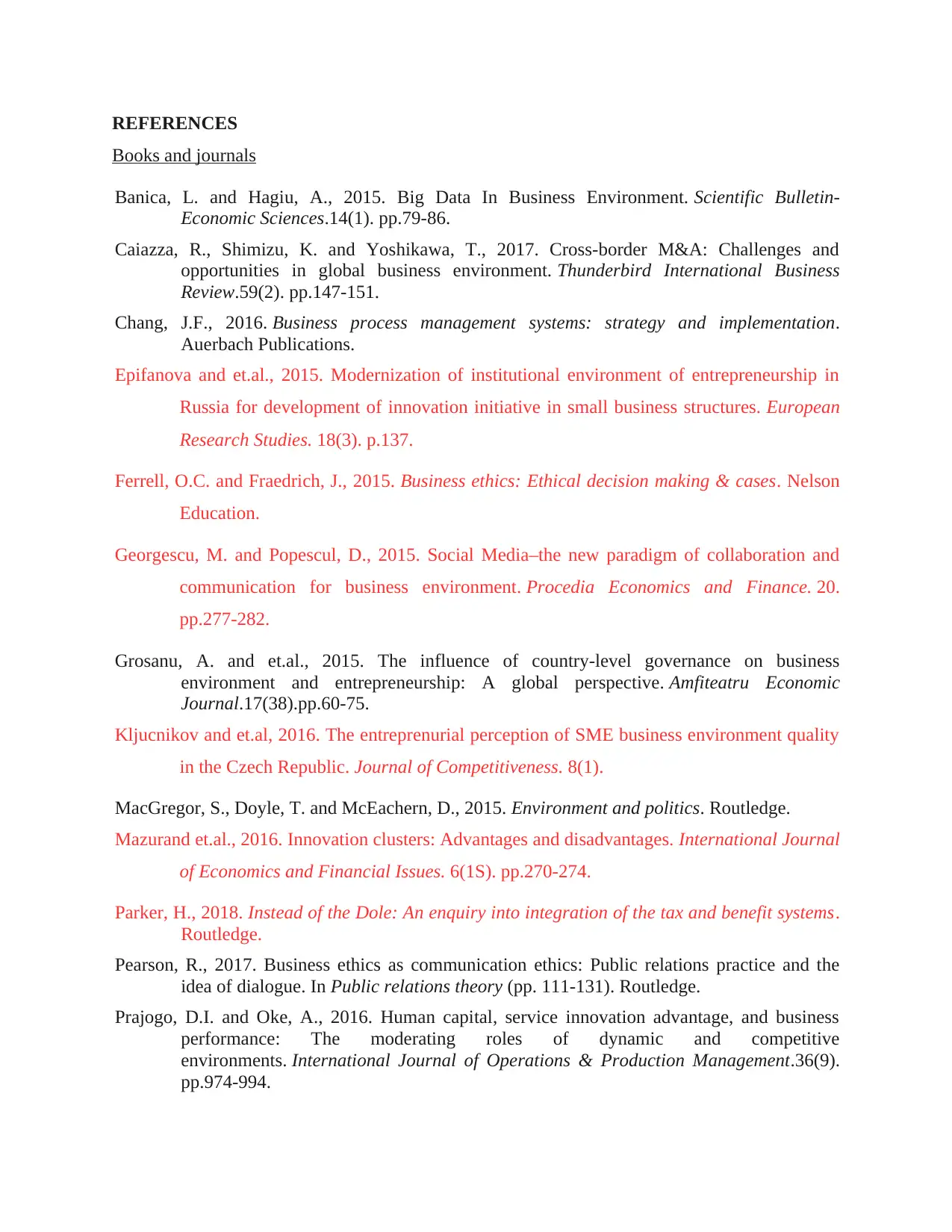
REFERENCES
Books and journals
Banica, L. and Hagiu, A., 2015. Big Data In Business Environment. Scientific Bulletin-
Economic Sciences.14(1). pp.79-86.
Caiazza, R., Shimizu, K. and Yoshikawa, T., 2017. Cross‐border M&A: Challenges and
opportunities in global business environment. Thunderbird International Business
Review.59(2). pp.147-151.
Chang, J.F., 2016. Business process management systems: strategy and implementation.
Auerbach Publications.
Epifanova and et.al., 2015. Modernization of institutional environment of entrepreneurship in
Russia for development of innovation initiative in small business structures. European
Research Studies. 18(3). p.137.
Ferrell, O.C. and Fraedrich, J., 2015. Business ethics: Ethical decision making & cases. Nelson
Education.
Georgescu, M. and Popescul, D., 2015. Social Media–the new paradigm of collaboration and
communication for business environment. Procedia Economics and Finance. 20.
pp.277-282.
Grosanu, A. and et.al., 2015. The influence of country-level governance on business
environment and entrepreneurship: A global perspective. Amfiteatru Economic
Journal.17(38).pp.60-75.
Kljucnikov and et.al, 2016. The entreprenurial perception of SME business environment quality
in the Czech Republic. Journal of Competitiveness. 8(1).
MacGregor, S., Doyle, T. and McEachern, D., 2015. Environment and politics. Routledge.
Mazurand et.al., 2016. Innovation clusters: Advantages and disadvantages. International Journal
of Economics and Financial Issues. 6(1S). pp.270-274.
Parker, H., 2018. Instead of the Dole: An enquiry into integration of the tax and benefit systems.
Routledge.
Pearson, R., 2017. Business ethics as communication ethics: Public relations practice and the
idea of dialogue. In Public relations theory (pp. 111-131). Routledge.
Prajogo, D.I. and Oke, A., 2016. Human capital, service innovation advantage, and business
performance: The moderating roles of dynamic and competitive
environments. International Journal of Operations & Production Management.36(9).
pp.974-994.
Books and journals
Banica, L. and Hagiu, A., 2015. Big Data In Business Environment. Scientific Bulletin-
Economic Sciences.14(1). pp.79-86.
Caiazza, R., Shimizu, K. and Yoshikawa, T., 2017. Cross‐border M&A: Challenges and
opportunities in global business environment. Thunderbird International Business
Review.59(2). pp.147-151.
Chang, J.F., 2016. Business process management systems: strategy and implementation.
Auerbach Publications.
Epifanova and et.al., 2015. Modernization of institutional environment of entrepreneurship in
Russia for development of innovation initiative in small business structures. European
Research Studies. 18(3). p.137.
Ferrell, O.C. and Fraedrich, J., 2015. Business ethics: Ethical decision making & cases. Nelson
Education.
Georgescu, M. and Popescul, D., 2015. Social Media–the new paradigm of collaboration and
communication for business environment. Procedia Economics and Finance. 20.
pp.277-282.
Grosanu, A. and et.al., 2015. The influence of country-level governance on business
environment and entrepreneurship: A global perspective. Amfiteatru Economic
Journal.17(38).pp.60-75.
Kljucnikov and et.al, 2016. The entreprenurial perception of SME business environment quality
in the Czech Republic. Journal of Competitiveness. 8(1).
MacGregor, S., Doyle, T. and McEachern, D., 2015. Environment and politics. Routledge.
Mazurand et.al., 2016. Innovation clusters: Advantages and disadvantages. International Journal
of Economics and Financial Issues. 6(1S). pp.270-274.
Parker, H., 2018. Instead of the Dole: An enquiry into integration of the tax and benefit systems.
Routledge.
Pearson, R., 2017. Business ethics as communication ethics: Public relations practice and the
idea of dialogue. In Public relations theory (pp. 111-131). Routledge.
Prajogo, D.I. and Oke, A., 2016. Human capital, service innovation advantage, and business
performance: The moderating roles of dynamic and competitive
environments. International Journal of Operations & Production Management.36(9).
pp.974-994.
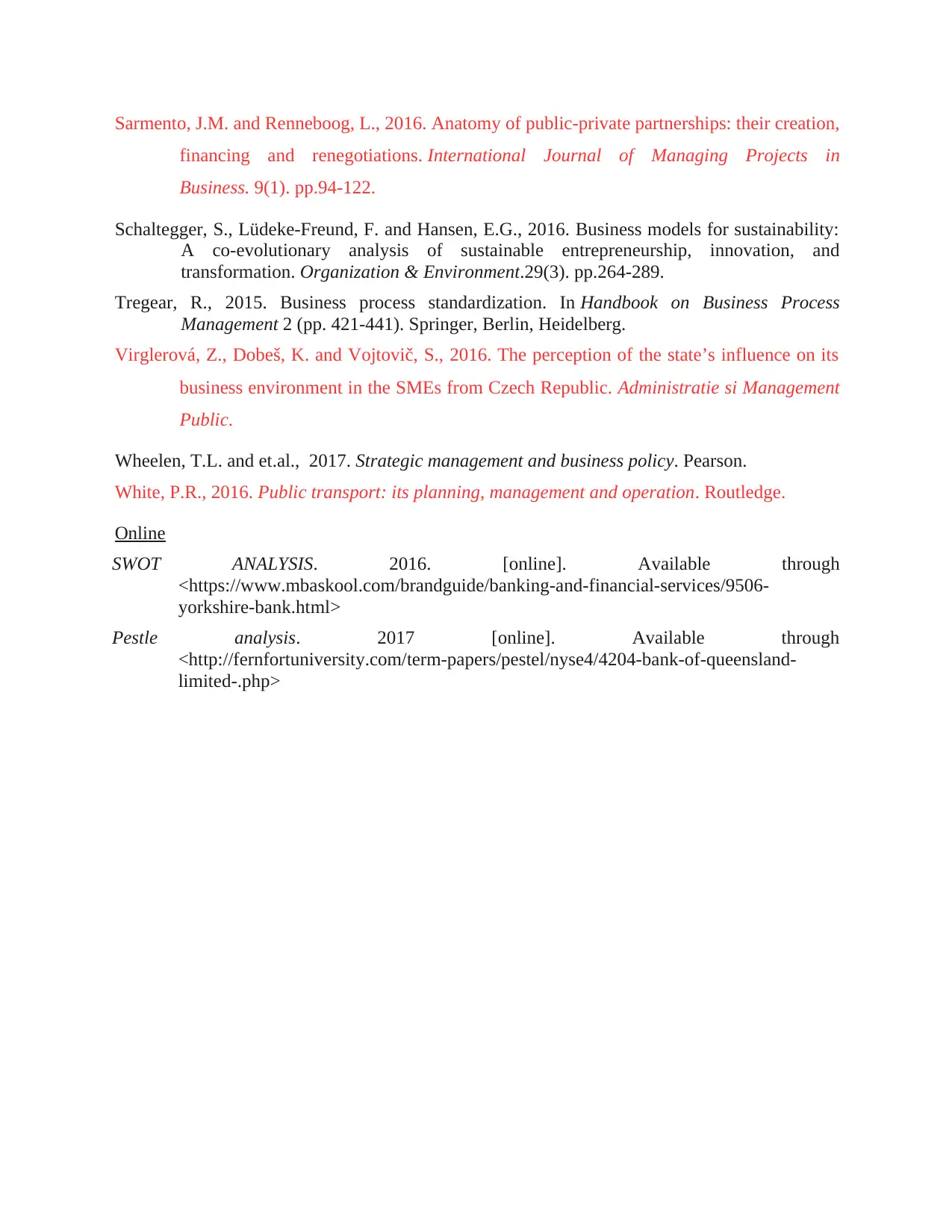
Sarmento, J.M. and Renneboog, L., 2016. Anatomy of public-private partnerships: their creation,
financing and renegotiations. International Journal of Managing Projects in
Business. 9(1). pp.94-122.
Schaltegger, S., Lüdeke-Freund, F. and Hansen, E.G., 2016. Business models for sustainability:
A co-evolutionary analysis of sustainable entrepreneurship, innovation, and
transformation. Organization & Environment.29(3). pp.264-289.
Tregear, R., 2015. Business process standardization. In Handbook on Business Process
Management 2 (pp. 421-441). Springer, Berlin, Heidelberg.
Virglerová, Z., Dobeš, K. and Vojtovič, S., 2016. The perception of the state’s influence on its
business environment in the SMEs from Czech Republic. Administratie si Management
Public.
Wheelen, T.L. and et.al., 2017. Strategic management and business policy. Pearson.
White, P.R., 2016. Public transport: its planning, management and operation. Routledge.
Online
SWOT ANALYSIS. 2016. [online]. Available through
<https://www.mbaskool.com/brandguide/banking-and-financial-services/9506-
yorkshire-bank.html>
Pestle analysis. 2017 [online]. Available through
<http://fernfortuniversity.com/term-papers/pestel/nyse4/4204-bank-of-queensland-
limited-.php>
financing and renegotiations. International Journal of Managing Projects in
Business. 9(1). pp.94-122.
Schaltegger, S., Lüdeke-Freund, F. and Hansen, E.G., 2016. Business models for sustainability:
A co-evolutionary analysis of sustainable entrepreneurship, innovation, and
transformation. Organization & Environment.29(3). pp.264-289.
Tregear, R., 2015. Business process standardization. In Handbook on Business Process
Management 2 (pp. 421-441). Springer, Berlin, Heidelberg.
Virglerová, Z., Dobeš, K. and Vojtovič, S., 2016. The perception of the state’s influence on its
business environment in the SMEs from Czech Republic. Administratie si Management
Public.
Wheelen, T.L. and et.al., 2017. Strategic management and business policy. Pearson.
White, P.R., 2016. Public transport: its planning, management and operation. Routledge.
Online
SWOT ANALYSIS. 2016. [online]. Available through
<https://www.mbaskool.com/brandguide/banking-and-financial-services/9506-
yorkshire-bank.html>
Pestle analysis. 2017 [online]. Available through
<http://fernfortuniversity.com/term-papers/pestel/nyse4/4204-bank-of-queensland-
limited-.php>
1 out of 16
Related Documents
Your All-in-One AI-Powered Toolkit for Academic Success.
+13062052269
info@desklib.com
Available 24*7 on WhatsApp / Email
![[object Object]](/_next/static/media/star-bottom.7253800d.svg)
Unlock your academic potential
© 2024 | Zucol Services PVT LTD | All rights reserved.





